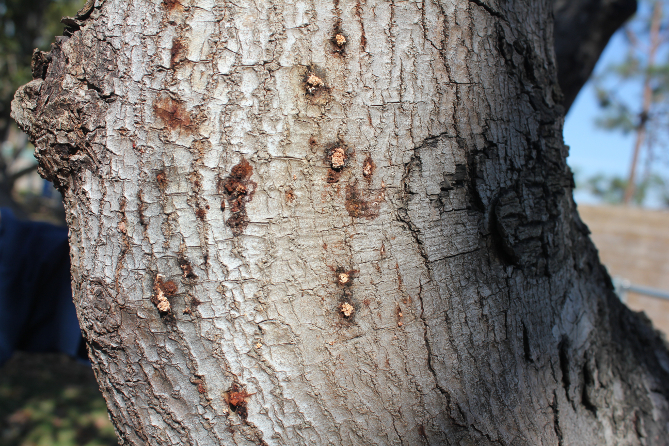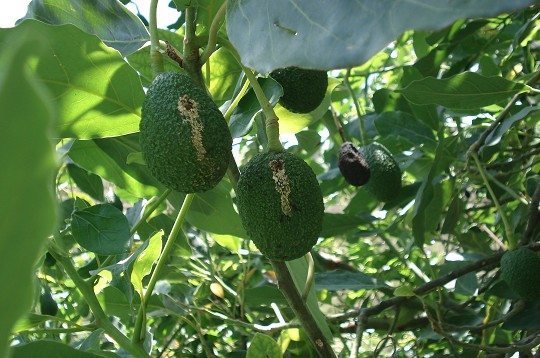
Branch Borer
Copturus Aguacatae
Pathogène :
Insect
Type:
Risque:
HIGH
Barrenadores




Descrição da doença
Copturus aguacatae is a beetle belonging to the family Curculionidae. This insect, commonly known as a branch borer, is a small, dark beetle whose main activity focuses on the branches and trunks of avocado trees. The adults emerge during the hot season and look for trees to lay their eggs. Females pierce the bark of the tree to lay their eggs in galleries that they excavate in the wood. The larvae hatch and begin feeding on the internal tissue of the tree, creating tunnels that interfere with the flow of nutrients and water. After completing their larval development, the larvae pupate within the wood and emerge as adults to repeat the cycle.
Descrição do patógeno
The disease caused by the branch borer in avocado is manifested through the structural and physiological damage caused by the beetle larvae when feeding on the wood of the tree. This damage can result in significant weakening of branches and, in severe cases, death of the tree. The main symptoms include wilting of leaves, dieback of branches, presence of sawdust or exudates on the bark, and reduced fruit production. Infestation may also predispose the tree to secondary infections by opportunistic pathogens.
• Wilting of leaves
• Branch dieback
• Presence of sawdust or exudates on the bark
• Reduction in fruit production
TEMPERATURA E UMIDADE
22ºC - 28ºC
65% - 75%
CAMINHOS DE TRANSMISSÃO</span
Flight of adults, movement of infested plant material, contaminated pruning tools.
CONTROL
Tratamento químico
• ORANGE OIL 6% [SL] P/V
• PARAFFIN OIL (CAS [64742-46-7]) 80% [EC] P/V
• PARAFFIN OIL (CAS [8042-47-5]) 54.6% [EW] P/V
• PARAFFIN OIL (CAS [8042-47-5]) 79% [EC] P/V
• PARAFFIN OIL (CAS [8042-47-5]) 83% [EC] P/V
• PARAFFIN OIL (CAS [97862-82-3]) 40% [EW] P/V
• Paraffin oil 65.4% [EW] P/V
• PARAFFIN OIL 81.7% [EC] P/V
• PARAFFIN OIL 83% [EC] P/V
• ACETAMIPRID 20% [SG] P/P
• AZADIRACTIN 1% (AS AZADIRACTIN A) [EC] P/V
• CHLORANTRANILIPROL 20% [SC] P/V
• DELTAMETHRIN 0.015% [RB] P/P
• DELTAMETHRIN 0.015g/trap [RB] P/P
• DELTAMETHRIN 0.03% (10 mg s.a./dispenser) [RB] P/P
• DELTAMETHRIN 2.5% [EC] P/V
• ALUMINUM PHOSPHIDE 56% (0.6 G/TABLET) [GE] P/P
• ALUMINUM PHOSPHIDE 56% (3 G/TABLET) [GE] P/P
• ALUMINUM PHOSPHIDE 56% [GE] P/P
• LAMBDA CYHALOTHRIN (0.0075 g s.a./trap) [RB] P/P
• LAMBDA CYHALOTHRIN 10% [CS] P/V
• LAMBDA CYHALOTHRIN 2.5% [WG] P/P
• MALTODEXTRIN 47.6% [SL] P/V
• PYRETHRINS 4% [EC] P/V
• PYRIPROXIFEN 10% [EC] P/V
• POTASSIUM SALTS OF FATTY ACIDS C14-C20 48% [EW] P/V
• SPINETORAM 25% [WG] P/P
Tratamento biológico
• ORANGE OIL 6% [SL] P/V
• PARAFFIN OIL (CAS [64742-46-7]) 80% [EC] P/V
• PARAFFIN OIL (CAS [8042-47-5]) 54.6% [EW] P/V
• PARAFFIN OIL (CAS [8042-47-5]) 79% [EC] P/V
• PARAFFIN OIL (CAS [8042-47-5]) 83% [EC] P/V
• PARAFFIN OIL (CAS [97862-82-3]) 40% [EW] P/V
• Paraffin oil 65.4% [EW] P/V
• PARAFFIN OIL 81.7% [EC] P/V
• PARAFFIN OIL 83% [EC] P/V
• AZADIRACTIN 1% (AS AZADIRACTIN A) [EC] P/V
• DELTAMETHRIN 0.015% [RB] P/P
• DELTAMETHRIN 0.015g/trap [RB] P/P
• LAMBDA CYHALOTHRIN (0.0075 g s.a./trap) [RB] P/P
• LAMBDA CYHALOTHRIN 10% [CS] P/V
• LAMBDA CYHALOTHRIN 2.5% [WG] P/P
• MALTODEXTRIN 47.6% [SL] P/V
• PYRETHRINS 4% [EC] P/V
• POTASSIUM SALTS OF FATTY ACIDS C14-C20 48% [EW] P/V
Traitements biologiques
• BACILLUS THURINGIENSIS AIZAWAI 50% [WG] P/P
• BACILLUS THURINGIENSIS KURSTAKI (STRAIN PB 54) (16x10E6 I.U./G) 8% [WP] P/P
• BACILLUS THURINGIENSIS KURSTAKI (STRAIN PB 54) (16x10E6 IU/G) 9.74% [SC] P/V
• BACILLUS THURINGIENSIS KURSTAKI (SA-12 strain) 18% ((8.5 X 10^12 CFU/KG)) [WG] P/P
• BACILLUS THURINGIENSIS KURSTAKI (EG 2348) (24x106 I.U./G) 18.3% [SC] P/V
• BACILLUS THURINGIENSIS KURSTAKI (EG 2348) 37.5% [WP] P/P
• BEAUVERIA BASSIANA (STRAIN ATCC 74040) 2.3% (2.3X10E7 VIABLE SPORES/ML) [OD] P/V
• BEAUVERIA BASSIANA (GHA STRAIN) 22% (4.4 x 10E10 CONIDIAS/G) [WP] P/P
• PAECILOMYCES FUMOSOROSEUS (STRAIN FE 9901) 18% (2 X 10 E9 CFU/G) [WP] P/P
Recomendações
• Regularly monitor avocado trees for signs of infestation, especially during the hot season.
• Carry out sanitary pruning to eliminate and destroy infested branches, preventing the spread of the beetle.
• Use pheromone traps to capture adults and reduce the population.
• Apply systemic insecticides to infested trees to reach and eliminate larvae within the wood.
• Maintain good overall tree health through proper watering and fertilization practices, which helps increase the tree's resistance to infestations.
• Avoid introducing infested plant material to unaffected areas to prevent the spread of the pest.
• Promote the diversity of the agricultural landscape to reduce the density of susceptible hosts.
TRAITEMENTS
Remèdes maison
There are no home treatments
Alliés naturels
Traitements chimiques
There are no treatments for this disease. Treatments are directed at the insect vectors that transmit it. See insect treatments.
RECOMMANDATIONS
- Check the back of the leaves frequently, especially in dry weather.
- Spray water on the leaves to increase humidity and prevent them from settling.
- Keep plants healthy with good watering and adequate light.
- If you see cobwebs or damage, clean the leaves with a damp cloth or pressurized water.
- Use potassium soap or neem oil every few days until they disappear.
Plantes répulsives
Rosemary, Dill, Coriander
PRODUITS RECOMMANDÉS
*Os tratamentos recomendados ainda são recomendações de acordo com os bancos de dados de autoridades e em nenhum momento substituem as diretrizes estabelecidas de acordo com a legislação de cada país
*Les produits présentés sont des recommandations et ne sont pas nos propres produits. En tant qu'associés Amazon, nous gagnons des revenus grâce aux achats de produits recommandés.





















